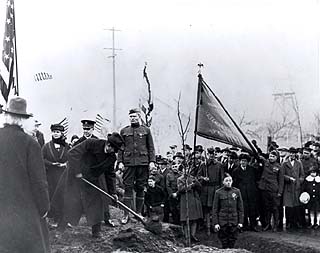
Surveys
DJC.COM
April 10, 2003
Weaving stories into a living corridor
SB&Associates

These 80-year-old elms, each planted in honor of a WWI veteran, shade and shelter Des Moines Memorial Drive. |
Many of us are lured into landscape architecture by the promise of discovery, the capacity to heal and transform, and the opportunity to help communities enhance their identity. The cultural enhancement plan for Des Moines Memorial Drive reminds us of all these dreams, and promises to make them a reality.
The project is about weaving memories into a plan for the future, and expressing contributions of the past in an urban corridor.
While the project extends beyond the boundaries of a typical site or program, it centers upon a 9-mile-long “Living Road of Remembrance,” a World War I veterans’ memorial initiated in 1921 around a brick road.
The drive, with its plaza and 80-year-old elms, extends from south Seattle at the South Park Bridge, through White Center and Boulevard Park in unincorporated King County, and the cities of Burien, SeaTac, Normandy Park and Des Moines.
The plan is funded through a King County grant. The county is leading the project, and collaborating with cities along the route, all of which have agreed to support and promote the project.
In addition to SB&Associates, the design team for the project includes cultural and heritage consultant Kay Reinartz and artists Maggie Smith and Jon Gierlich. The project is a collaborative effort between consultants and city and county agencies, the Des Moines Memorial Drive Committee, the Highline and Des Moines historic societies, veterans organizations and the many constituents who have kept the memorial alive over the years.
Committee member and steward Rose Clark, Burien deputy mayor, says, “... It’s remarkable, but not surprising given the people here, that we have saved and protected over all these years many of the memorial trees. You need to know that each one of the 1,800 trees originally planted was designated to a WWI veteran from Washington state and we hold that to be a very important obligation.”
The corridor plan is a unique opportunity to preserve the hopes and dreams of many. For starters, it is one of the few WWI roads of remembrance in the country that still has its trees.
And, the list of stakeholders is very impressive: the Seattle Garden Club; United States and French veterans; scenic travel route enthusiasts, such as the infamous Sam Hill; the American Forestry Association; and local dignitaries of the 1920s.

|
Des Moines Memorial Drive is really a composition of many historic and contemporary pathways, nodes and roads, including Native American trails, Military Road, Highline Road, Hamilton’s Folly, Kelly’s Road and Des Moines Way; and a rich and extensive mosaic of open space, habitat, historic buildings and other community resources.
The planning team, along with the host communities, is compiling stories, photos, remembrances and historic facts about the corridor. It will soon be making recommendations on replanting, tree rehabilitation, key intersection and community identity celebration spaces, monument restoration, memorial gathering spaces, interpretive educational displays, lighting and signage. Public meetings, fliers, posters, newsletter articles and an updated traveling exhibit about the corridor are being circulated during the planning period.

A monument to an unknown soldier, above, and a historic photo bring the perspective of time to the corridor project. |
The plan has three principal goals: first, to restore and enhance the WWI veterans memorial, the Des Moines Memorial Drive that is a Living Road of Remembrance; second, to strengthen other natural, cultural and heritage resources of corridor communities; and third, to establish an effective implementation strategy.
The second goal includes increasing corridor recognition and attractiveness. That means signature portals and gateways, quality memorial features and enhancements such as event lighting, flags and banners. Educational and interpretive displays and programs will play a part. The corridor will bring new meaning to the term “Living Road of Remembrance” with celebrations and parades.
As one of the first heritage corridors in a major urban setting in the state, the project will stand as a model for how communities can express their unique cultures and histories through corridor planning.
The Des Moines Memorial Drive project is more than the sum of its parts. It is a way to address important social issues as we examine our history and discuss our future. This is more important than ever as we attempt to understand and respond to the meaning and reality of memorializing and honoring veterans, then and throughout the 20th century — and now, at the beginning of the 21st century.
Jay Rood is president of SB&Associates and leads the design team for the cultural enhancement plan for Des Moines Memorial Drive.
Other Stories:
- Another scenic century
- Telling the story in the land
- Landscape architects adapt to changing world
- Seattle’s best outdoor spaces
- To stand at the edge of the sea
- Transportation and landscape design
- Olympic Sculpture Park: a Northwest collage
- Growing urban oases
- Volunteers build community
- Celebrating sustainable water systems
Copyright ©2009 Seattle Daily Journal and DJC.COM.
Comments? Questions? Contact us.